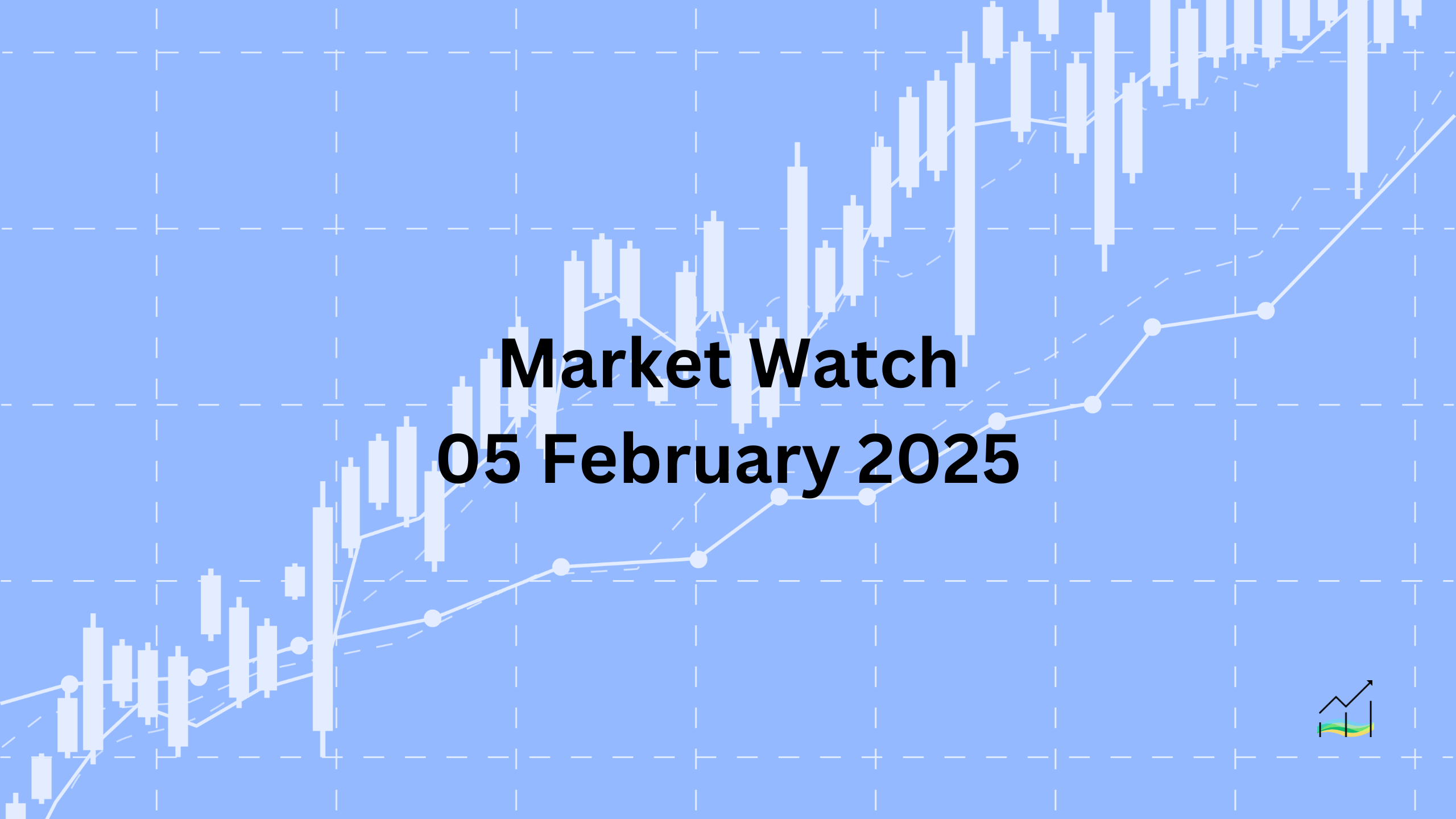05/02/2025 Market Watch

Dollar Weakens on Economic Shifts
The US dollar continues to trade lower as it pulls back from recent highs triggered by tariff concerns. It is weaker against all G10 currencies and most emerging market currencies. The Japanese yen leads the gains among major currencies, rising over 1% due to stronger-than-expected wage growth and softer US 10-year yields. Meanwhile, the Canadian dollar, though weaker among the G10, is still up about 0.35% and nearing its yearly high. Among emerging markets, most currencies are strengthening, except for the Chinese yuan, which remains under pressure.
China’s mainland market reopened after the extended Lunar New Year holiday, but stocks declined, including those trading in Hong Kong. However, most major markets in Asia posted gains. In Europe, the Stoxx 600 is trading flat after a modest 0.20% gain yesterday, while weak corporate earnings are weighing on US equity futures, signaling a lower open.
Bond markets are seeing a rally, with European 10-year yields falling by 3-6 basis points. The US 10-year yield, which had been holding above 4.50%, is now at 4.47% ahead of the US Treasury’s quarterly refunding announcement. Meanwhile, gold has surged to a new record high above $2,870 after settling below $2,800 last week. In the oil market, March WTI is fluctuating within yesterday’s range, having briefly touched $73 before pulling back to around $72.
United States of America
Overview
The Dollar Index is extending its decline after a weak close yesterday. It has dropped below the 107.50 support level, with further downside potential toward last month’s low near 107.00. Markets are closely watching upcoming economic data releases and policy signals for further direction.
Economic Drivers
The US economy is showing resilience despite some weak spots. The ADP private sector employment report is expected to show improvement from December’s 122K figure. However, the December trade deficit is projected to widen significantly. January auto sales came in lower at 15.6 million SAAR, but the two-month average remains one of the highest since mid-2021, possibly due to preemptive buying amid tariff concerns.
Data and Events
A heavy slate of US data is in focus, including the final services and composite PMI readings, as well as the services ISM index. Additionally, the Treasury’s quarterly refunding announcement will be closely watched. Treasury Secretary Bessent may look to adjust the debt issuance strategy, addressing prior concerns over reliance on short-term bills rather than long-term bonds. However, immediate changes may not materialize. The Federal Reserve continues its balance sheet roll-off of $25 billion per month, with no signs of an imminent halt.
Price Action
The Dollar Index’s decline reflects shifting sentiment as markets anticipate steady Fed policy in the near term. Gold remains elevated, and Treasury yields are being closely monitored. Meanwhile, President Trump has authorized the creation of a sovereign wealth fund. The US Treasury’s $125 billion Exchange Stabilization Fund could be partially allocated toward a broader investment strategy beyond traditional reserve assets.
Key Points:
- The Dollar Index is falling below support at 107.50, with further downside toward 107.00.
- ADP private payrolls expected to improve, but trade deficit likely to widen.
- Treasury refunding announcement may address past debt issuance strategies.
- Fed balance sheet roll-off continues at $25 billion per month.
- Trump approves a sovereign wealth fund using part of the Exchange Stabilization Fund.
Australia
Overview
The Australian dollar has broken key resistance near $0.6240 and extended its rally, reaching around $0.6290. A further move above $0.6300 could open the door to last month’s high near $0.6330. Market sentiment remains positive as Australia’s economic data shows signs of improvement.
Economic Drivers
Australia's economic outlook is gaining traction with an uptick in business activity. The final composite PMI for January was confirmed at 51.1, an improvement from the initial estimate of 50.3 and breaking out of the 50.2 range seen over the last three months of 2024. This marks the first increase in the composite PMI since October, signaling a modest recovery in economic momentum.
Data and Events
Attention now turns to Australia’s December goods trade balance, set for release tomorrow. The surplus is expected to narrow to approximately A$6.5 billion. In the first 11 months of 2024, the country’s goods trade surplus shrank significantly to A$66.2 billion from A$111.9 billion in the same period in 2023, highlighting a slowdown in trade dynamics.
Price Action
The Australian dollar has regained strength, overcoming key technical resistance. If it clears $0.6300, the next upside target is $0.6330. A failure to hold current levels could see some retracement, but the improving economic backdrop may continue to support the currency.
Key Points:
- Australian dollar broke resistance at $0.6240, rising to around $0.6290.
- Final composite PMI confirmed at 51.1, first increase since October.
- December goods trade balance expected to narrow to A$6.5 billion.
- Trade surplus for Jan-Nov 2024 dropped to A$66.2 billion from A$111.9 billion in 2023.
- A move above $0.6300 could target last month’s high at $0.6330.
Canada
Overview
The US dollar has weakened against the Canadian dollar, reaching a nine-day low near CAD1.4300 yesterday and extending losses to almost CAD1.4270 today. Last month’s low was around CAD1.4260, with the next key support level near CAD1.4200.
Economic Drivers
The narrowing of Canada’s bond yield spreads has contributed to the Canadian dollar’s strength. The two-year yield differential, which hit a 28-year extreme of over 160 basis points yesterday, has pulled back slightly. The 10-year spread has also narrowed after reaching a record high above 150 basis points. This shift suggests some easing in interest rate expectations.
Data and Events
Market sentiment has been influenced by the potential economic impact of tariff threats. The swaps market is adjusting its outlook on Bank of Canada rate cuts, pricing in nearly 65 basis points of easing for the rest of the year—up from 45 basis points just a week ago. This reflects growing expectations of policy adjustments amid economic uncertainty.
Price Action
The Canadian dollar has gained momentum as the US dollar continues to face selling pressure. If the USD/CAD pair breaks below CAD1.4260, the next downside target is CAD1.4200. However, any shift in rate expectations or trade developments could influence the currency’s direction.
Key Points:
- USD/CAD fell to a nine-day low near CAD1.4300 and extended losses to CAD1.4270.
- Last month’s low was around CAD1.4260, with support near CAD1.4200.
- Canada's bond yield spreads have slightly narrowed after hitting extreme levels.
- Swaps market now expects nearly 65 basis points of Bank of Canada rate cuts, up from 45 basis points last week.
- Further downside in USD/CAD could target CAD1.4200 if selling pressure continues.
China
Overview
The US dollar's rally against the offshore yuan (CNH) has reversed following extreme volatility tied to tariff concerns. After closing near CNH7.24 on January 27, the dollar spiked above CNH7.36 during Monday’s turmoil before retreating to CNH7.2750 yesterday. The pullback has now extended slightly below CNH7.27.
Economic Drivers
The sharp dollar movement was driven by shifting market sentiment around US tariff policies. Initial concerns pushed the greenback higher, but a reassessment of the situation has led to a retreat. Additionally, China’s economic outlook remains a focal point, as policy decisions from Beijing continue to shape investor confidence.
Data and Events
The People's Bank of China (PBOC) set the dollar’s reference rate at CNY7.1693, barely changed from the pre-Lunar New Year fix of CNY7.1698, signaling stability despite recent fluctuations. Meanwhile, January’s Caixin PMI readings were softer than expected, with services PMI dropping to 51.0 (from 52.2) and the composite PMI slipping to 51.1 (from 51.4). However, the data had little impact on market sentiment.
Price Action
The yuan strengthened as the dollar’s retreat continued. If the USD/CNH pair stays below 7.27, it could suggest further downside momentum. However, market sensitivity to any new policy announcements or trade developments remains high.
Key Points:
- USD/CNH surged past 7.36 on tariff fears before retreating below 7.27.
- Market sentiment shifted as concerns over tariffs eased.
- PBOC set the dollar reference rate at CNY7.1693, signaling stability.
- Caixin PMI data showed weaker services (51.0) and composite (51.1) figures, with little market reaction.
- Further downside for USD/CNH remains possible if 7.27 holds as resistance.
Europe
Overview
The euro is gaining momentum, trading above $1.04 for the first time this week, extending its recovery from Monday’s dip to $1.0140. The currency is approaching a key resistance zone between $1.0440 and $1.0465.
Economic Drivers
While economic data played a minimal role in driving the euro’s movement, the final services and composite PMI were in line with earlier estimates, having little impact on the market. However, political factors are playing a significant role in shaping sentiment, particularly in France. The government’s use of a constitutional provision to bypass parliament and adopt this year’s budget has created turmoil. A no-confidence vote is likely, but the Socialists’ abstention ensures the government’s survival for now. Political instability continues as the Socialists threaten another no-confidence vote regarding migration reform once the budget is settled.
Data and Events
The final services and composite PMI data in the eurozone were in line with expectations, showing no major surprises. Additionally, the political situation in France remains a focal point. Meanwhile, Germany is set to hold elections on February 23, adding another layer of political uncertainty to the region.
Price Action
The euro is showing resilience, pushing above $1.04 after a low of $1.0140 earlier in the week. It is now approaching resistance near $1.0440-$1.0465, which could cap its immediate upside.
Key Points:
- Euro pushes above $1.04, extending recovery from Monday's low.
- Key resistance is near $1.0440-$1.0465.
- France’s political turmoil continues with a no-confidence vote over the budget and potential further instability over migration reform.
- Germany’s upcoming elections on February 23 could add to political uncertainty.
- Final services and composite PMI data were in line with initial estimates and had minimal market impact.
Japan
Overview
The US dollar recorded an inside day against the Japanese yen and has continued its downward trajectory today. The dollar has dropped to ¥152.55, its lowest level since mid-December, following stronger Japanese wage data and softer US yields. This has led the dollar to retrace to the 61.8% level from the December low of ¥148.65.
Economic Drivers
Stronger-than-expected Japanese wage growth has raised speculation that the Bank of Japan may hike rates in early Q3. Labor cash earnings in December rose 4.8% year-over-year, the largest increase since 1997. When adjusted for inflation, real cash earnings increased by 0.6%. Additionally, bonuses saw a notable 6.8% rise. However, cautionary signs come from a more robust measure of wages, which showed a smaller increase, standing at 2.8% in December compared to 3.0% in July. Japan's CPI data showed inflation at 3.6% for the headline figure and 3% for the core rate, signaling continued price pressures.
Data and Events
Japan’s final services and composite PMI readings did not provide new insights. Economic growth data showed Japan's economy expanded by 1.2% on an annualized basis in Q3, with similar growth expected for Q4. For Q1 and Q2 of 2025, growth is forecasted to remain around 1%.
Price Action
The US dollar has dipped to ¥152.55, marking its lowest level since mid-December. The 61.8% retracement level from December’s low is now acting as technical support. The next key support target for the dollar may be around ¥151.50. Resistance is now expected around the ¥153.70-80 area, which formed a shelf over the past week and a half.
Key Points:
- Dollar drops to ¥152.55, lowest level since mid-December.
- Strong Japanese wage growth fuels speculation of a rate hike by the Bank of Japan in early Q3.
- Japan’s CPI shows inflation at 3.6% (headline) and 3% (core).
- Japan's economic growth remains steady at around 1% annually.
- Technical support for the dollar near ¥151.50, with resistance at ¥153.70-80.
United Kingdom
Overview
The British pound has been strengthening, driven by broader US dollar weakness, as the Bank of England prepares for its meeting tomorrow. A quarter-point rate cut is largely anticipated, with the market already pricing in another cut at the May 8 meeting. The pound reached $1.25 yesterday and has gained further today, with a potential target of $1.2600.
Economic Drivers
Sterling’s strength appears to be more reflective of the broader US dollar movement than domestic economic developments. The UK’s final composite PMI for January showed a slight improvement, but it fell short of expectations, edging up to 50.6 from December's 50.4, and down from the preliminary reading of 51.2. This marks a significant slowdown compared to January 2024's 52.9.
Meanwhile, the UK-US rate differentials have shifted. The US two-year premium reached 8 basis points on Monday, the highest since August, but has since narrowed to 5 basis points. In mid-January, the UK had a 20 basis point premium. The US 10-year premium also widened to 7 basis points on Monday, the most in five months, but is now down to just 2 basis points. As of early January, the UK had a 10 basis point premium.
Data and Events
The Bank of England’s rate decision tomorrow is the focal point, with a quarter-point rate cut expected. The market is also looking toward the May 8 meeting for another potential rate cut.
Price Action
The British pound has risen to $1.25 and is continuing its upward trajectory today. The next resistance level may be around $1.2600.
Key Points:
- The British pound strengthens, reaching $1.25 and continuing to rise.
- Market anticipates a quarter-point rate cut from the Bank of England tomorrow, with another expected in May.
- The final UK composite PMI showed a modest increase to 50.6, lower than the preliminary 51.2 reading.
- US-UK rate differentials have shifted, with the US gaining a premium in both the 2-year and 10-year segments.
- The next key target for the pound is around $1.2600.
© 2025 SKONE Enterprise (003319453-V). All rights reserved.
The content on this site is for informational purposes only and does not constitute financial advice.


